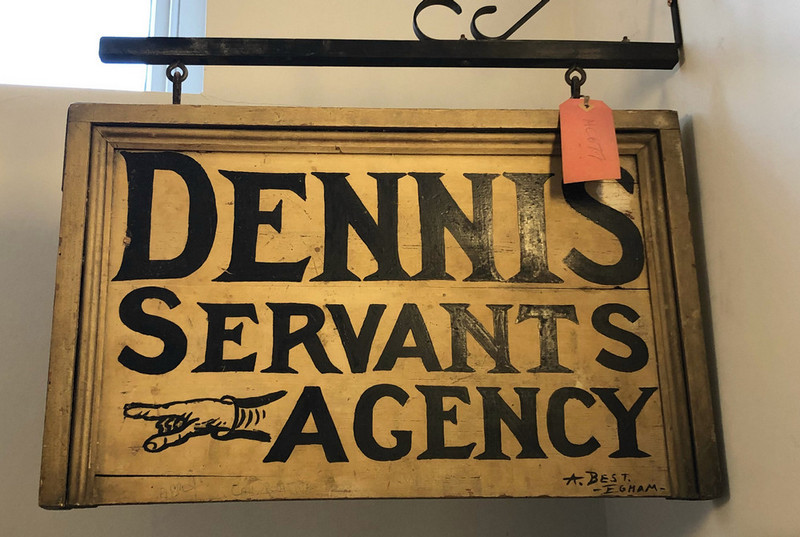Dennis Servant’s Agency
In the Museum’s collection we have object number MC677, ‘Dennis Servant’s Agency’ sign board 1900’s, Egham High Street.

There is a record of a ‘Domestic Servants Registry’ at number 90 High Street Egham from 1932-1947. It is likely that the ‘Dennis Servant’s Agency’ sign came from this domestic servants registry. Until the end of 2018, No.90 was home to Egham Dental Care.
Servants Registries/Agencies:
Servant registries are said to have been established around the middle of the 18th century.
Typically, servants found work through word of mouth recommendations, references from previous employers or adverts in newspapers. Alternatively, there were servant’s registries, the equivalent of today’s employment agency.
Servant registries were a place where both employers and servants could seek help or work without having to advertise. Many servants who had just arrived in a new town or who had no success in finding employment through word of mouth recommendations, could go to a servant’s registry agency. They would most likely enter their name, job skills, and the kind of employment they were seeking in a registry book.
There were different types of servant registry offices. Some registries required a fee upfront from both employer and servant for the registry’s services. Some registries were free for servants to use and the employer paid. Though, the servant might be asked to pay a fee after finding employment
There was a notable expansion of servant agencies during the Victorian period due to a rise in demand for servants by the middle class. Most towns had at least one servant’s agency whereas larger cities often had numerous agencies.
We assume that Dennis Servant’s Agency was Egham’s servant registry office.
Households who were looking for servants could contact a servant’s agency with their requirements, such as the type of servant and the salary that would be provided. Often the lady of the house was in charge of finding servants.
The agency would match up servants with employers based on the information provided. Larger servant’s agencies sometimes had private booths where prospective servants could be interviewed by their potential employer. Good ‘character’ references were often crucial in securing a position.
Fraudulent registry offices:
Most servant registry offices were not regulated. There were many reliable registries, but some set up misleading advertisements, taking servants service fees knowing that there were no vacancies available.
Some registries would register as many servants as possible so that they could offer a wide range of choices to prospective employers. While this practice benefited the employers and registry offices, it meant that fewer positions were available than the number of servants who were registered.
Compulsory government licensing of registry offices within the London County Council Area was not instituted until the early 20th century (1907). The licences could be revoked if there were complaints of ill practice.
References:
P2008B, ‘Dennis Servant’s Agency’ sign, Egham Museum Photograph Index,
P3675, ‘Egham Museum – Servant’s uniform – COS157’, Egham Museum Photograph Index.
‘Domestic Servants Registry’ at number 90 High Street Egham from 1932-1947, Egham Museum Egham High Street North Side Index.
Michelle Higgs, A Visitor’s Guide to Victorian England, (Barnsley: Pen and Sword, 2014)

